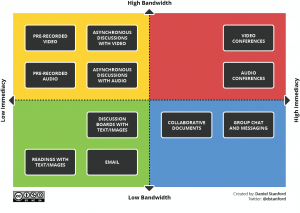15 Video and Media
Creating Video Lectures
eLearning courses often successfully use online lectures as a method of delivering course content. The Centre for Pedagogical Innovation suggests the use of Snagit or LifeSize for lecture recording, Camtasia or Vegas for editing, and various solutions for hosting your lecture videos once they are ready to be viewed.
Tips on Video Production
A 2014 paper by Guo, Kim and Rubin titled How Video Production Affects Student Engagement: An Empirical Study of MOOC Videos, presented an empirical study of how video production affected student engagement in 862 videos from four edX courses offered in the Fall 2012 to 128,000 students. Guo’s seven summarized recommendations from his 2014 blog post match the CPI’s guidance and experience:
Content File Types Used in Web-enriched Courses
There are a variety of file types that will contribute to your course website. Depending on the content and media you select to complement your course goals, you may capture and edit video files, develop written content in HTML, or simply distribute lecture notes in PDF. The following file types are used most commonly by instructors in course websites:
- HTML files are the most common files used on the Internet. Generally, we recommend generating these files for your course site because they are easily accessible for students. Many instructors write their content in SoftChalk, an easy-to-use HTML editor that offers functionality similar to document creators such as Microsoft Word, but offers added tools to create directories and integrate with course sites. Alternatively, instructors may choose to use familiar programs such as Microsoft Word and save documents as HTML pages.
- PDF (Portable Document Format) files are very popular for distribution via the Internet. PDF files are excellent for disseminating papers, readings, or image-rich lecture materials, and tend to be more accessible than many other types of web-based documents.
- Word files are often uploaded by instructors to their course site. Because some students may not have similar or up-to-date programs with which to read DOC files, a safe measure would be to save Word files as RTF files. Note that doing so should keep nearly all formatting provided by Microsoft Word intact.
- PowerPoint is another file type popular among instructors. Because PPT files are often completely inaccessible if the end user does not have a compatible version, and because file sizes are generally much larger than is recommended, consider exporting the text or slides to Word (File > Send To > Microsoft Word), which gives you the same content in a more manageable format. It is also possible to export a PowerPoint presentation to PDF.
Low-bandwidth Teaching
Remote teaching and learning brings with it a number of considerations and challenges. If learners are able to connect to free/institutional networks (e.g., from local libraries, or on-campus student work areas), they will likely be able to access a safe, reliable, and robust internet connection. However, if these learners are relying on home-based connections, these will likely have a slower speed connection, and their service may be shared with others in their house (for work, or education, or entertainment).
Daniel Stanford’s article provides some guidance on the impact of videoconferencing on bandwidth and immediacy. His Bandwidth Immediacy Matrix (embedded below) prompts educators to shift our thinking, “[b]y reflecting on the unique pros and cons of each zone and the drawbacks that come with high-bandwidth/high-immediacy tools, we can identify ways to make our courses more flexible and accessible.”

Here’s a quick definition of internet bandwidth.
While we’re considering activities that lower the bandwidth, it’s also to have a refresher on how to optimize images, PDFs, etc. for effective distribution before you post them to your LMS or send them via email. We’ve broken these down into separate pages, linked below. These solutions are also mostly based on our experience working on Mac platforms, and there are likely some Windows-based tools that should be included here.
Tips on Course Web Page Design
Instructional web sites need to meet a variety of requirements. Pages must contain quality information. In addition, the site should be visually pleasing, download quickly, and have intuitive navigational features.
For additional information on general style and layout issues, as well as issues specific to the Internet, consult Yale’s Web Style Guide.

